Mural Walk
The Town of Legal is known as the French Mural Capital of Canada. On November 21, 2011, the Town of Legal was also recognized as the French Mural Capital of the World per capita.
There are over 35 murals proudly displayed around Legal, welcoming visitors to this bilingual community. Legal's strong cultural heritage has collaborated with the L'Association canadienne-française de l'Alberta régionale Centralta to bring this project to life. The Town now flourishes with a wonderful display of murals. Tourists from around the world have come to Legal for a taste of Northern Alberta culture.
While you are experiencing the wonders of the Mural Walk remember to stop in at the local cafe for a snack, wander the shops on main street and enjoy an evening at Centennial RV Park.
Did You Know...
Murals are for everyone. Explore Alberta's history through the eyes of a child or the wisdom of a senior. Reflect upon the accomplishments of our nations forefathers, enjoy today and create a vision for the future. Turn your day of adventure into a mural hunt to engage the whole family.
L'Association canadienne-française de l'Alberta régionale Centralta is available to provide bilingual guided tours to visitors. To book a tour or to find out more information about the Murals of Legal, please call the ACFA Centralta at 780-961-3665.
Resources
Browse the Mural Gallery below and bring awareness to the lifelike art placed around Town. Join us anytime for an in-person viewing.
Cause Lavoie Case

In 1941, the federal government ordered a national census. Alexandre, his wife Mary, and their four children could not find bilingual forms in time to fill in the census. The federal government fined the Lavoies $7,700, which is the equivalent of $100,000 today, for late filing. He was appalled by the lack of consideration and challenged the fines in court. After a second appeal, with Lionel Tellier as his lawyer, the judge acquitted the Lavoie family and federal census forms have since become bilingual.
Louis Riel
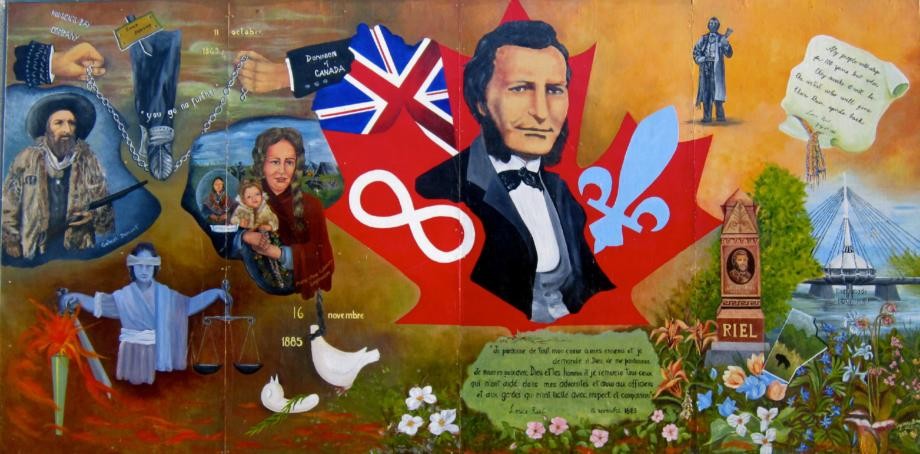
Louis Riel led the resistance of the Métis and homesteaders against the federal government. The government was building a railroad on farmers’ land without their permission. In this mural, we see the portrait of his friend Gabriel Dumont, his mother Marie-Anne Gaboury, and himself at the center. In the bottom left corner, we see the flames representing the decision to hang him which then changes to blood and later flowers.
Irish Immigration
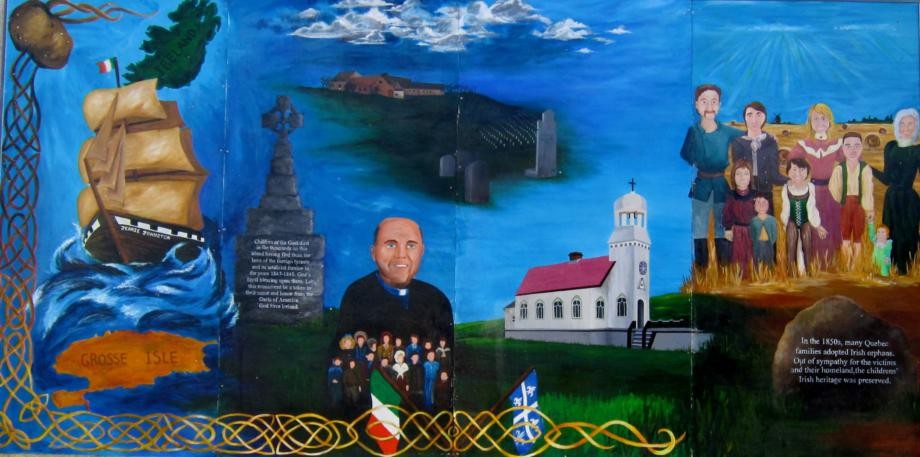
Irish Immigration began when potatoes, their staple crop, became diseased. The Irish fled to many places including Canada, but one quarter to one half of all immigrants did not make it to their destination. They arrived at Grosse île, where priests and nurses would try to heal the sick. Children who were orphaned were then cared for by the church. Hospitable French families adopted them and gave them a second chance at life.
Oblates
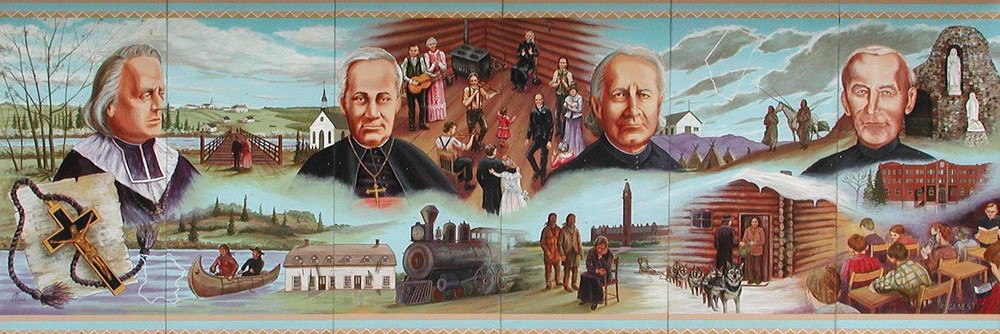
Eugène de Mazenod, OMI, far left, founded the Oblates in Aix-en-Provence, France in 1826. Oblates were priests dedicated to missionary work and helping the poor by being part of their everyday lives. Bishop Vital Grandin, OMI, served all of northern Alberta. Father Albert Lacombe, OMI, assisted the Transcontinental Railway to cross Western Canada in 1883. Blessed Brother Antoine Kowalczyk, OMI, served many years at the francophone boys’ residential school at Edmonton’s St. Jean College (red building) in the 40's and 50's. In the center, we see St. Albert, Alberta, at its very beginning.
ACFA
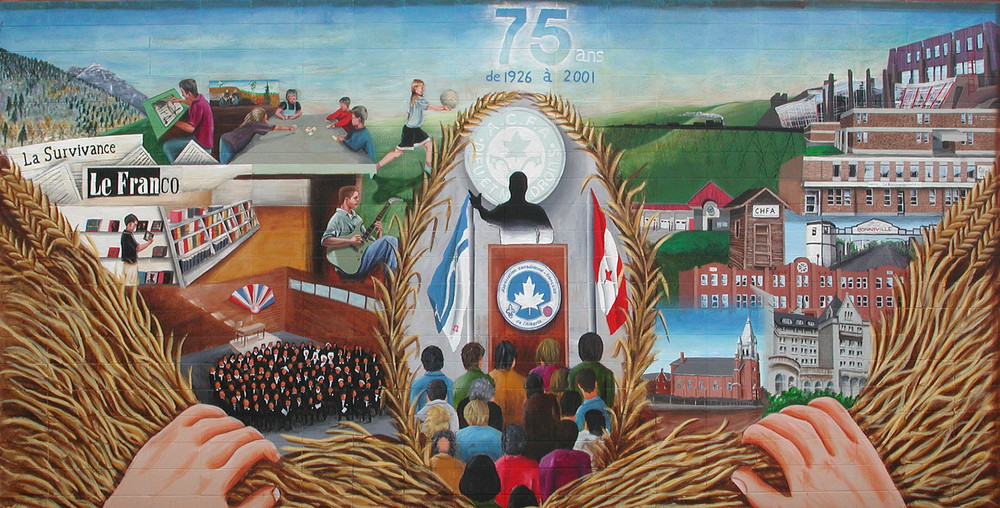
What?! There are French-speaking Canadians in the West?! On the right are the francophone institutions that make up part of the ACFA’s (the French-Canadian Association of Alberta) history. The left side of the mural shows activities supported by the ACFA, which augment Franco-Albertan vitality. In the center is a gathering of people for their annual meeting.
Bugnet
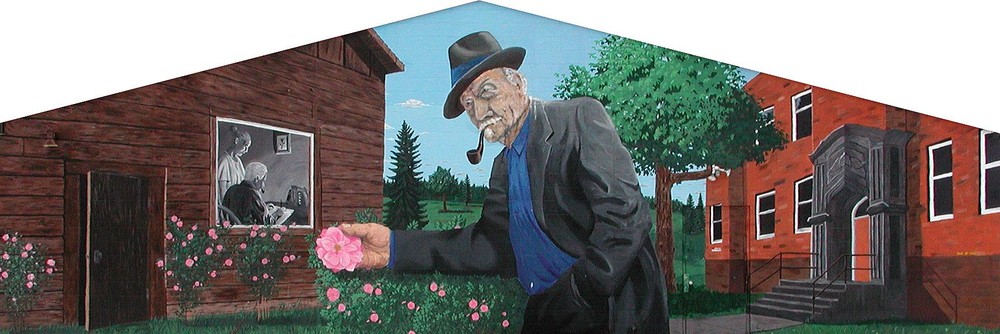
Thérèse Bugnet roses appear all over the mural — the creation of this rose is one of the crowning achievements of George Bugnet. Look closely and notice how the top part of the stems of the roses have no thorns. On the left is Bugnet’s first house. Looking through the window, we see George hard at work writing one of his books with his wife, Julia, offering her support. On the right is l’École George et Julia Bugnet (the George and Julia Bugnet School), which led to a Supreme Court decision on minority-rights education.
Chauvet
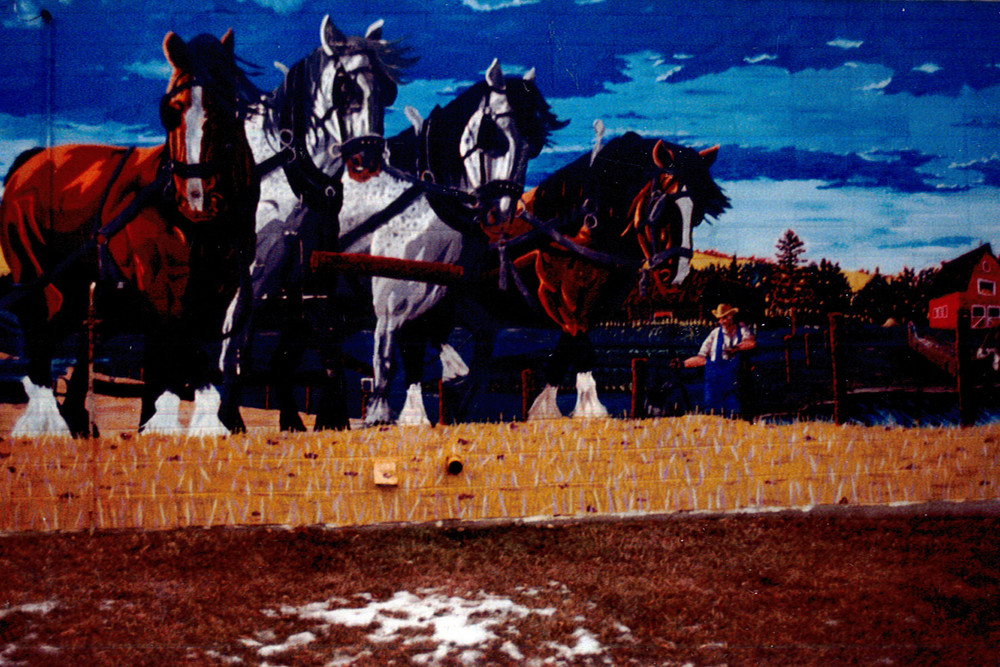
Jean-Marie Chauvet immigrated from France and is seen on the bottom right of this mural. He valued education and most of his children received a post-secondary education. Paul, his eldest son, is depicted on a horse-drawn plow reading a book. This is to illustrate the challenge of getting an education during the era of horses.
Skateboard Ensemble

On the North side, we see the Union Jack with a young person skateboarding towards the middle. On the South side, there is a youth skateboarding on top of the Quebec flag towards the middle. The skateboarders meet in the center above the Canadian flag. The mural symbolizes the two European founding nations coming together to form our country.
Father Primeau
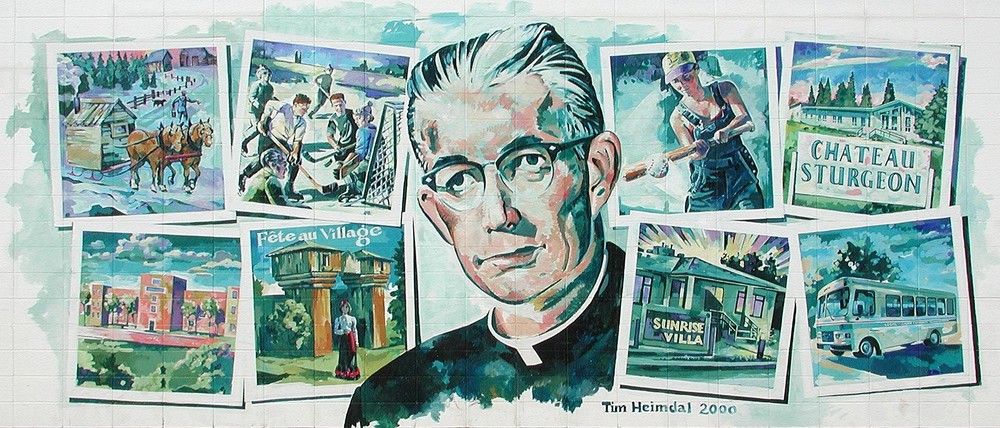
Father Primeau was a born leader; he could organize various activities with few resources on hand. He was instrumental in organizing the baseball teams, hockey teams, and weaving courses, and was the driving force behind Citadelle Park. Father Primeau initiated “Fête au Village” in Legal. From 1958 to 1966, he was Legal’s parish priest.
Knights of Columbus

The Knights of Columbus have four pillars: patriotism, fraternity, charity, and service. Over the years, they have contributed to community activities, funded activities for the youth, and affirmed the value of life. This was the first mural in Legal painted on canvas material.
de Champlain

The mural depicts the family of Joseph and Marie-Anne de Champlain at suppertime during the yearly harvest. It became tradition to stop threshing and gather in the field for supper with the whole family. The de Champlain family was inspired by their ancestors’ love of the land. The descendants still operate around 11,000 acres (roughly 4,600 hectares) in the Legal area as of 2013.
Legal School
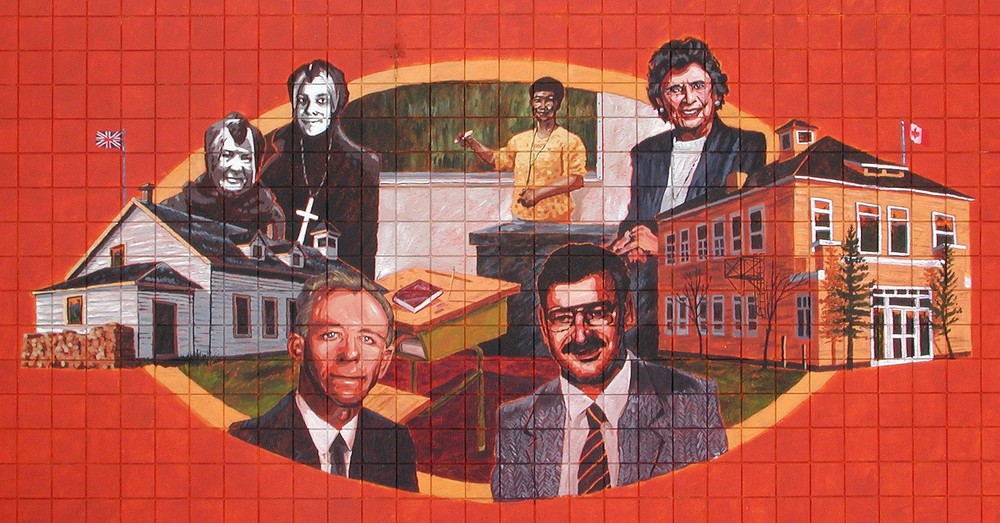
This mural depicts the highlights of individuals in the development of schools in Legal. In 1915, Legal received the approval for the construction of a new school. The two sisters painted in white distinguishes them from those who were alive during the painting of the mural. The two women near the top taught for more than 30 years, while the men near the bottom were both principals for more than 13 years.
Grey Nuns
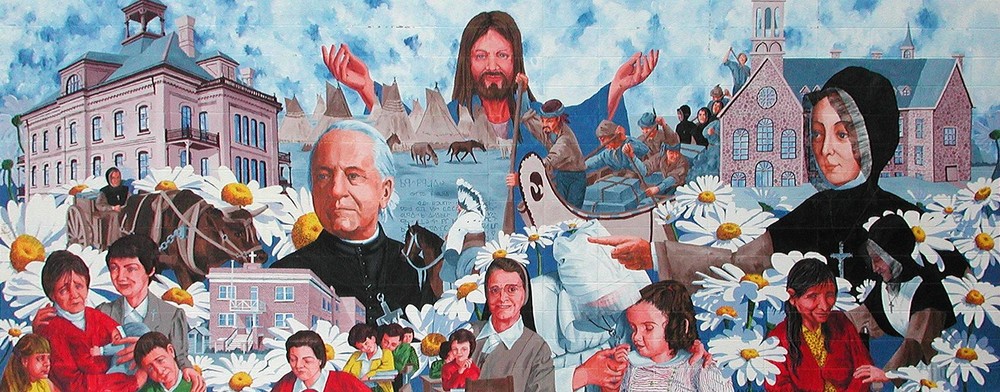
Marguerite d’Youville founded the Grey Nuns in 1737. The daisies, called marguerites in French, unifies the contributions of the Grey Nuns. They cared for the sick, abused women, and orphans, and they also taught in many Alberta schools. The mural includes: Marguerite d’Youville (upper right), the Edmonton General Hospital, their motherhouse in Montréal, the Sacred Heart Convent (which hosts Legal’s Francophone school), and the first three sisters who came to Alberta by canoe.
Trompe-l'oeil
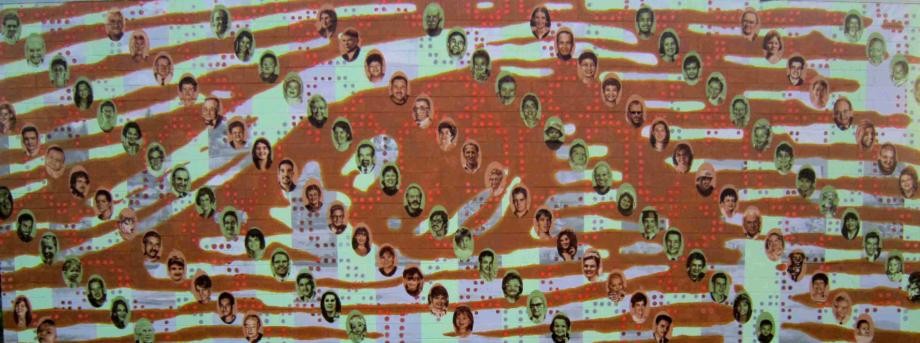
The Michaud brothers collected 180 individual portraits and created one large image of their mother’s eye. Called a “Trompe oeil”, up close one can see a collage of pictures in the mural and from about one mile away the picture alters to that of an eye.
Father Morin

Attracted by Father Morin’s advertisement for cheap Albertan homesteads, 620 families came to the area from 1891-1899. Using every means of transport available, they came from Quebec, the United Sates, and even Europe. Without phones and modern means of communication, almost 2,500 Francophones settled in the Edmonton area during the late 1800's, hoping for a brighter future.
Fortin
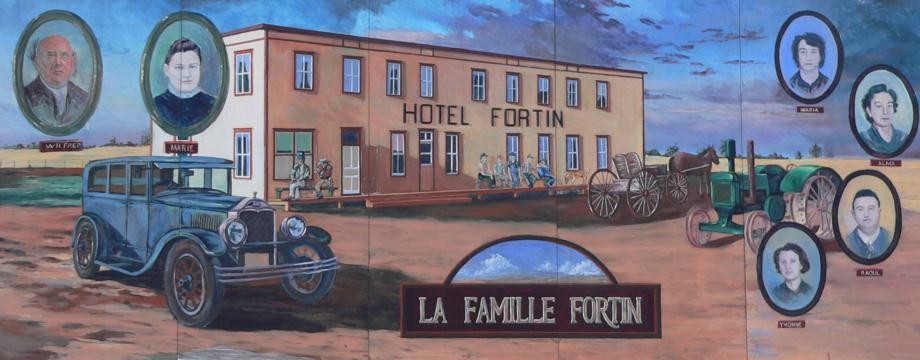
Wilfred Fortin married Marie Girard in Quebec in 1897. From their marriage, four children were born: Maria, Alma, Raoul, and Yvonne. The Fortin family decided to follow other francophone settlers and travelled west where they arrived in Legal in 1909. Wilfred built a store with an addition for housing freighters; the store’s addition became an overpopulated inn.
Gelot-Tieulie
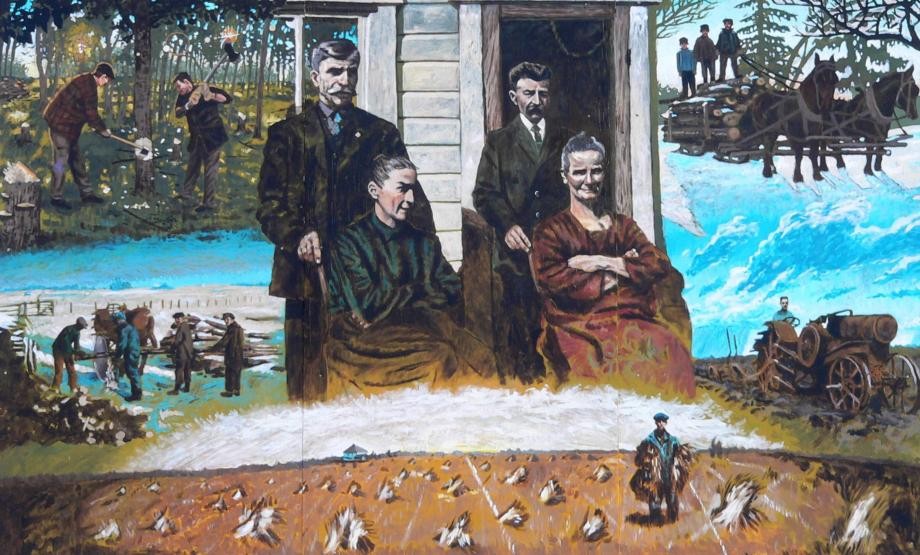
The Gelot and Tieulié families present the challenges of working the land. Early settlers would cut trees down using axes and bucksaws before hauling them away with horses. These were later used for firewood or to build houses. They would then dig up the roots of the trees before plowing the land. Here, they are using steel wheeled tractors instead of horses for the task. Finally, crops were sown and later placed in stokes for harvest.
Le Caveau
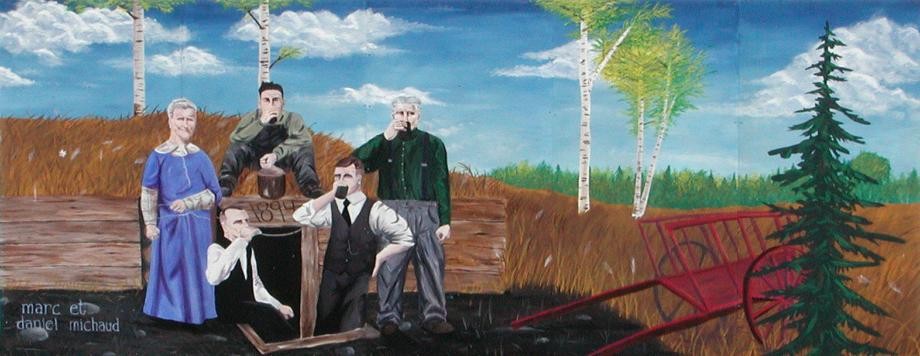
Théodore Gelot and Eugène Ménard were French settlers working in Californian vineyards. The two friends set out for Edmonton and each purchased a homestead in 1894. To satisfy the government’s land requirements, they built a small vault on the line between their homesteads, combining them.
Coulombe

This mural honors the 50th wedding anniversary of Delphis and Marie-Claire Coulombe. A farming and thinking out-of-the-box family, they are depicted harvesting hay and using horses to make the hay stack higher. In the mural Marie-Claire is using her spinning wheel and in the bottom right corner is one of their sons, who became the first priest of the Saint-Paul Diocese.
Auger
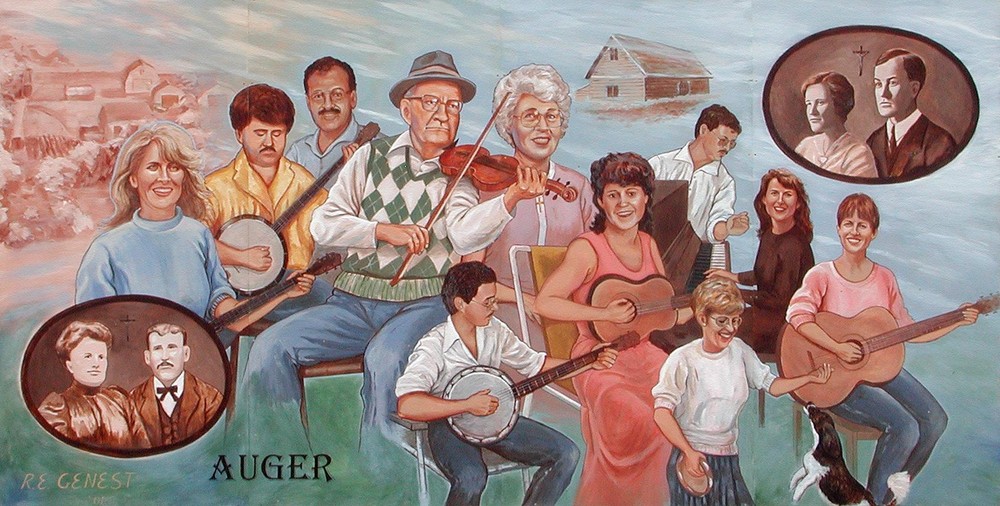
Germain and Cécile Auger are depicted with their children playing instruments. Music and singing were part of the family’s yearly gatherings. These joy-filled evenings, found in so many francophone families of the past, are very much a part of everyday French-Canadian culture.
Canada Post

This mural celebrates 100 years of bilingual postal service in Legal. In 1900, Ménésippe Massie was appointed the first postmaster. At first, mail was delivered once a week from Morinville via Pony Express. Later, the railway came which allowed the postal service to run three times a week. On the mural, we see the portraits of postmasters who have served for more than 25 years. They include Ben and Marie-Ange-St. Martin, Denis Limoges, and Rosaline Pelletier. We see Delphis Coulombe delivering the mail in his postal wagon. The children were added to depict the inclusion of youth in the project.
Credit Union
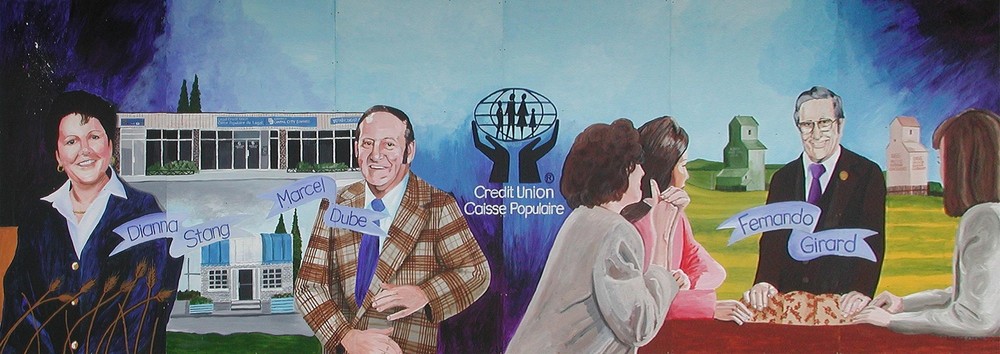
The Credit Union movement in Canada originated in Quebec. This mural presents (from left to right) Fernando Girard, Dianna Stang, Marcel Dubé, and Helen Prefontaine who were all veteran managers of the Legal Credit Union. Fernando Girard was very involved with the cooperative movement with the Francophones of Alberta and he is also the founder of the Francalta Credit Union.
Ukrainian Mural

Sponsored by Francophones to honor the Ukrainians of Legal, this mural starts on the left hand (east) side with a map of Ukraine. We then see reminders of Ukraine by the use of the colors, a ship crossing the ocean, Ukrainian dancers, a prayer of gratitude by the farmers, and the name of neighboring communities with significant Ukrainian presence. Finally, we notice the fleurs-de-lis and Ukrainian words of welcome to show the cooperative spirit between the two ethnic groups.
Legal Co-op
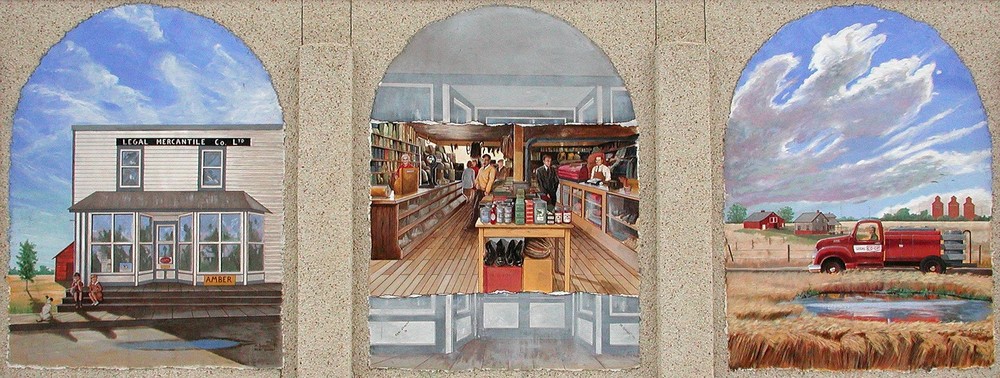
In 1924, eight entrepreneurial farmers, a lawyer, and a merchant founded Legal Co-op. It began with $201.88. During its baby years, Co-op sold petroleum products to the area’s farmers. When Co-op bought Legal Mercantile (left panel) from Edmond Dozois in 1926, the business added general merchandise. The mural portrays the many people who worked there for a number of years.
St. Martin-Calage
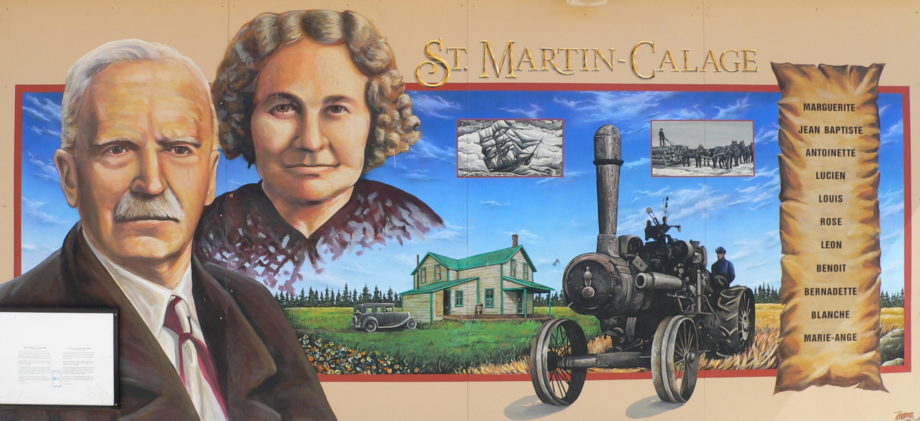
Joseph St. Martin married Marthe Calage in 1902. The ship near the middle of this mural represents their dangerous journey across the Atlantic Ocean from Argentina to Canada, then to Legal. The mural depicts the couple’s homestead, which the family owned until 1982. Joseph farmed, bred horses, and cared for other farm animals. The second photograph depicts the log hauling Jean Calage did with his sons and stepsons throughout winter. The giant tractor shows what the early farmers had to work with.
St. Arnaud
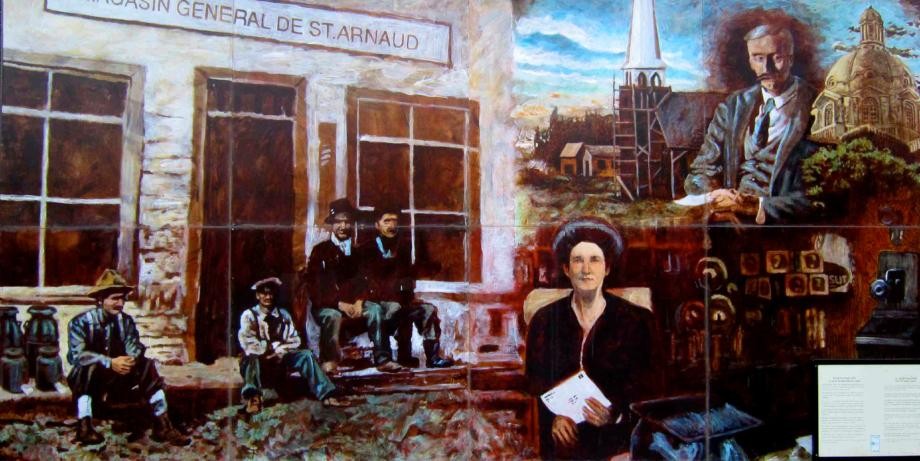
Télesphore arrived in Legal in 1900 and opened the Magasin Générale de St. Arnaud. In 1904, Télesphore became Legal’s postmaster. When demand rose for a church closer to Legal (top center), Télesphore was the committee secretary overseeing the construction. Télesphore was a member of the United Farmers of Alberta Party and in 1921, he won the provincial election, granting him a seat in the Legislature (top right).
Prefontaine
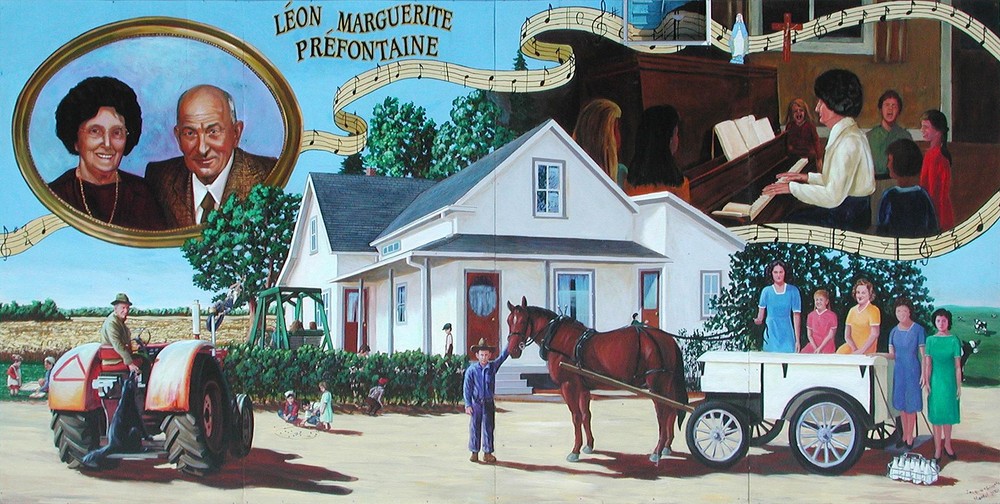
Léon Préfontaine and his wife Marguerite Coulombe were married in 1925. The couple had strong beliefs in three things, which they passed on to their children: faith, work, and fun. Léon Préfontaine began work at five a.m. with a melody on his lips. His daughters helped him by singing as they milked cows before and after school.
Letourneau-Caron

Patrice Létourneau and his brother Hubert arrived in the Legal area with their wives, Zénaïde and Elisabeth, in 1898-99. The two Létourneau families united and established a winter supply trail from Edmonton to Athabasca Landing in 1907. They brought pipes and supplies to the landing and, when the river’s ice broke, barges carried essential supplies across to the town Norman Wells in the Northwest Territories where oil had been discovered. When Louis Oscar Caron came to Legal in 1908, he joined the Létourneau business and his descendants now own Caron Transport in Alberta.
Charrois
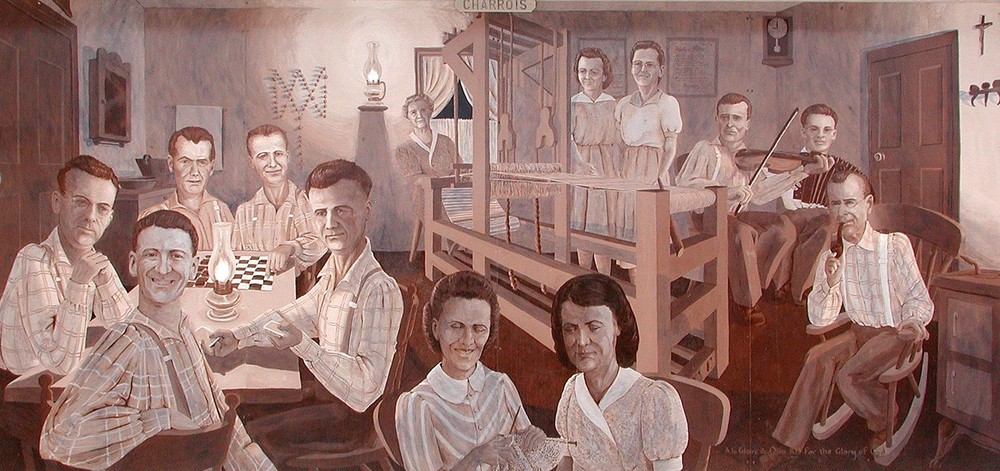
This mural was painted for the Charrois Family Reunion in 2000. The family always wanted to be together, as in the mural, but were unable to all be present at a single event. It is painted like an old photograph to unite the family that could not be together. They organized group activities and sometimes huddled by the woodstove during the coldest hours, fighting off the isolation brought on by winter. Each activity in the mural represents what each family member liked the best.
Canadian Forces
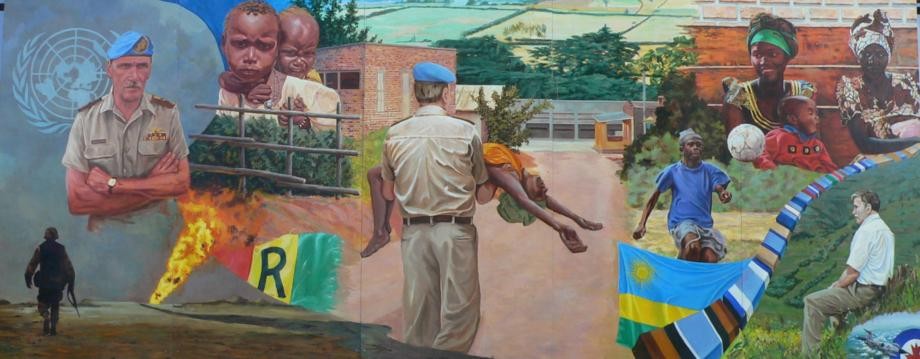
In 1994, Romeo Dallaire was put in charge of the UN’s Peace Keeping Forces in Rwanda. In the bottom left, we see oil fields burning as a reminder that there was no oil there. Towards the left side of the mural, we see the impact of war with the children being the victims. Towards the center, Romeo Dallaire is carrying a woman off the road. The mural transitions from the brutalities of war to a new hope for the country.
Cyr

Roger and Maria Cyr were strong advocates of John Deer implements. Three of their sons followed their parents’ love of the land and became accomplished farmers. This mural also highlights the family’s love of hockey in the top left corner, and their mom’s strong spirituality is represented by Maria Cyr holding a rosary. Notice how the artist presented the trade mark of each child’s interest in the wood carving.
Garneau
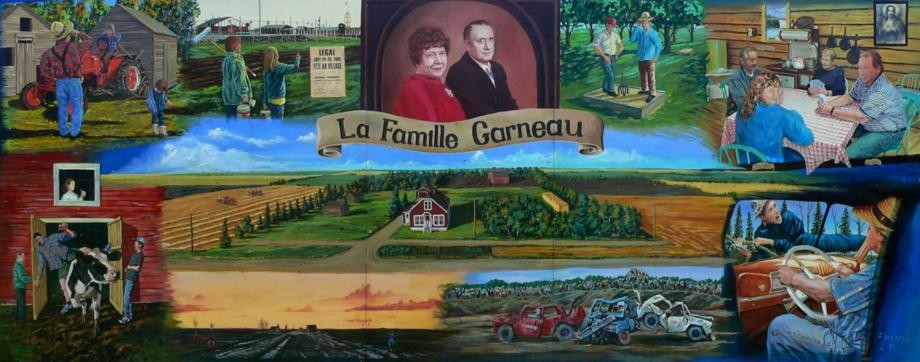
Farming for the early settlers consisted of hard work, accidents, and the occasional memorable prank. Central to this mural is the well-maintained farm site. In the four corners, we have the scenes of backing into a granary, children laughing as one of their cousins falls from a steer, demolition derbies, and one of the children miscalculating the Tarzan swing. We see the family’s involvement in the erection of the local Citadelle Park and playing a friendly game of both horseshoes and cards.
Francophone Youth
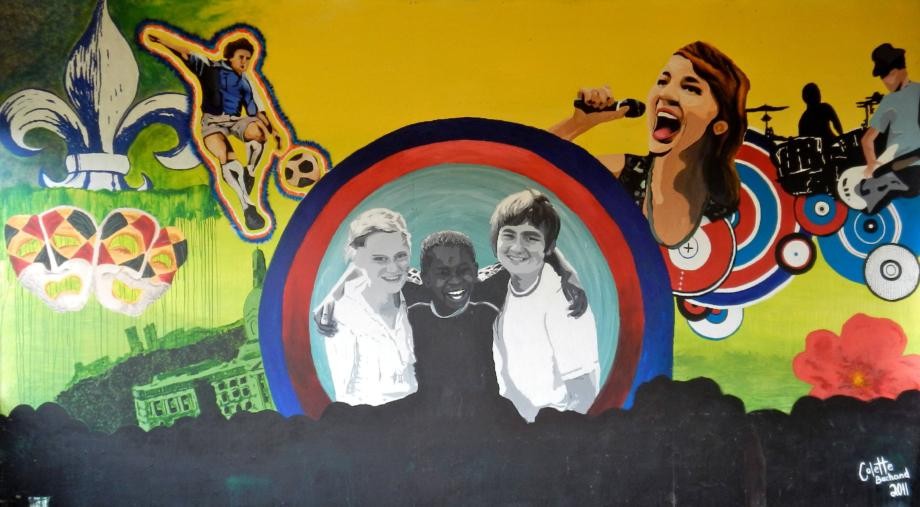
This mural illustrates the activities of Francophone youth in Alberta for example the Youth Parliament, the Youth Drama Festival, the Youth Francophone Games, and “La Chicane” (which is similar to a battle of the bands). The fleur-de-lis and the Alberta Wild Rose represent the Francophones of Alberta. Many of these activities are organized by the Francophone Youth of Alberta.
Maisonneuve
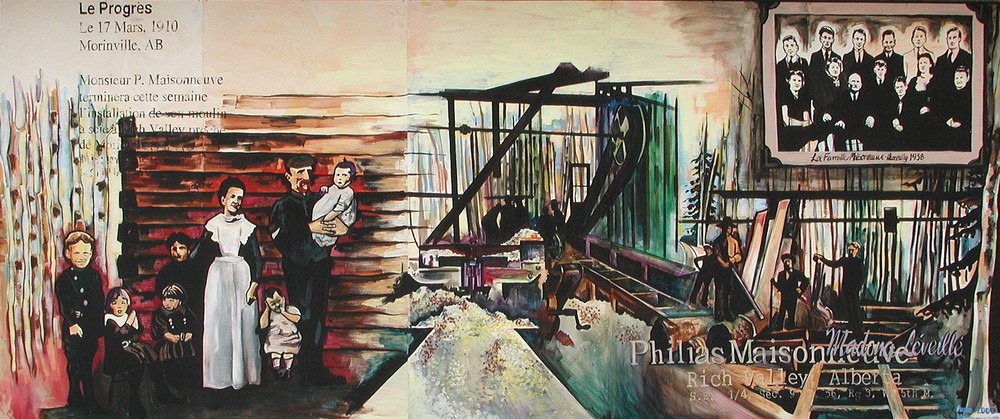
The Philias Maisonneuve family operated a sawmill in Rich Valley from 1910 to 1915. Quebec-Canadians had experience in logging camps, sawmills, and construction sites. Philias’s sawmill is an example of the French-Canadian role in the transition from logs to planks in Alberta. This mural depicts their sawmill in operation.
Pelletier
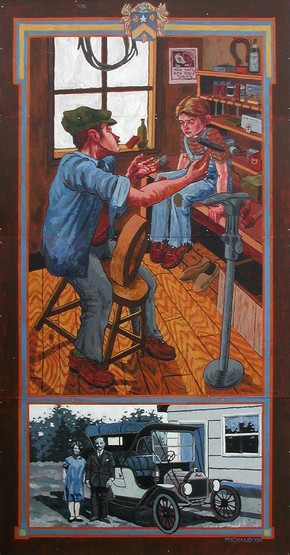
Émile, his wife Lumina, and their son, were the fifth family to live in Legal. He built a log cabin next to what is now Main Street where he established himself as Legal’s first cobbler. In the mural, Émile imparts his life experience and cobbling trade to his son, Adrien. At the bottom of the mural we see Émile and his wife Aline, who he married in 1928. They stand by their modest vehicle and home (circa 1917).
CHFA
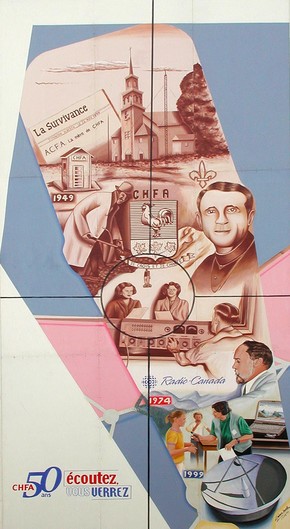
This mural was painted to celebrate the 50th anniversary of CHFA (680AM). CHFA [Courage, Honour, Fierté (pride), and Amour (love)] is the first French radio chain in Western Canada. On the mural, you see the CHFA’s 1949 beginnings near Saint-Paul’s Catholic church, which evolves to present day technology near the bottom.